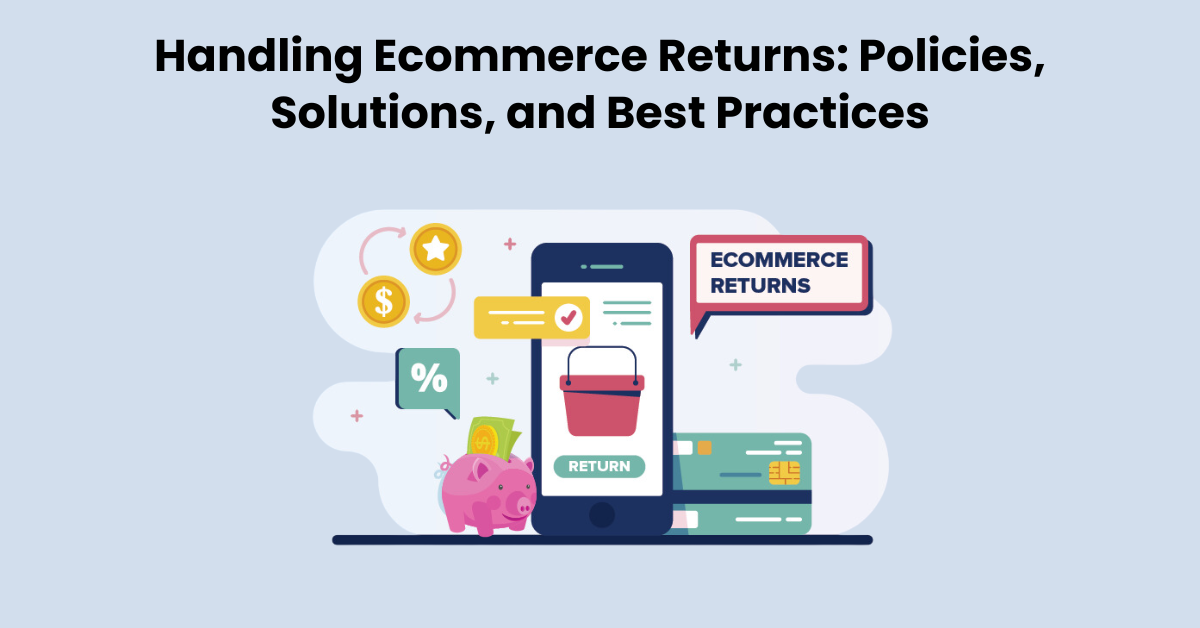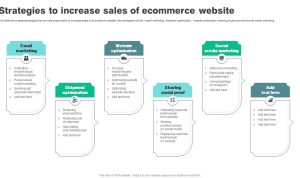How to Handle Returns and Refunds in E-commerce sets the stage for a crucial aspect of online shopping that can make or break a customer’s experience. In the fast-paced world of e-commerce, having a well-structured return and refund policy is not just a formality; it’s a key ingredient in building customer trust and loyalty. With online shoppers increasingly expecting flexibility and understanding when it comes to returns, businesses must navigate this landscape thoughtfully to mitigate losses and enhance satisfaction.
This overview will delve into the essential elements of return policies, the return process, and the importance of timely refunds, while also addressing how effective communication and fraud prevention play vital roles in shaping a positive customer journey.
Understanding Returns and Refunds
Having a clear and transparent return and refund policy is vital in the e-commerce realm. This policy not only builds trust with customers but also sets expectations on how to handle their purchases post-sale. A well-defined policy can reduce confusion and enhance customer satisfaction, ultimately leading to increased loyalty and repeat business.Customers initiate returns and requests for refunds for various reasons.
Some common triggers include receiving the wrong item, the product not meeting their expectations, defects, or simply changing their minds. Understanding these motivations helps businesses refine their product offerings and customer service strategies, contributing to a smoother shopping experience.
Common Reasons for Returns and Refunds
Several factors contribute to the decision of customers to return products or request refunds. Recognizing these reasons can assist e-commerce businesses in adjusting their practices and minimizing returns. Below are key reasons why returns occur:
- Incorrect Item Received: Customers often receive items that do not match their order, leading to dissatisfaction.
- Product Not as Described: When products do not align with the description or images provided, customers may feel misled.
- Defective Products: Items that arrive damaged or malfunctioning are a significant reason for returns.
- Fit Issues: This is particularly relevant in clothing and footwear, where sizing discrepancies can lead to returns.
- Change of Mind: Sometimes, customers simply decide they no longer want the item after purchase.
Understanding return rates in e-commerce is crucial for businesses. Statistics indicate that approximately 30% of all e-commerce purchases are returned, a figure that can vary significantly by industry. For example, the fashion industry often experiences higher return rates, sometimes exceeding 40%.
“High return rates can imply issues with product quality or misaligned customer expectations, highlighting the importance of accurate product representation and sizing information.”
These statistics not only impact the bottom line of businesses but also their logistics and inventory management. As such, addressing the root causes of returns through improved product descriptions, customer education, and quality control can lead to enhanced profitability and customer retention.
Creating a Return Policy
Crafting a well-defined return policy is essential for any e-commerce business. It not only sets clear expectations for customers but also establishes a level of trust that can encourage purchases. An effective return policy can differentiate your brand in a competitive market, promoting customer satisfaction and loyalty.A comprehensive return policy should address several key components including time frames for returns, acceptable conditions for items, and the processes customers need to follow.
Additionally, creating a policy that instills confidence among customers is crucial. Below are some important aspects to consider when drafting your return policy.
Key Components of a Return Policy
An effective return policy should clearly Artikel the specific details that customers need to know. These components include:
- Time Frames: Specify the duration within which customers can return products, typically ranging from 14 to 30 days after delivery.
- Conditions for Return: Clearly define the condition in which items can be returned. For example, products must be unworn, unused, and in original packaging.
- Return Process: Describe the steps customers must follow to initiate a return. This includes how to package the item, any return labels needed, and where to send the return.
- Refund Method: Artikel how refunds will be processed (e.g., original payment method, store credit) and the expected time frame for processing.
- Exclusions: Mention any items that are non-returnable, such as personalized or perishable goods.
Best Practices for Drafting a Return Policy, How to Handle Returns and Refunds in E-commerce
To build customer trust and encourage purchases, consider best practices while drafting your return policy. Implementing the following practices can enhance customer confidence:
- Simplicity: Use straightforward language and avoid complex legal jargon. A clear policy is easier for customers to understand.
- Transparency: Be upfront about any fees associated with returns, if applicable. Hidden charges can lead to frustration.
- Customer-Friendly Approach: Prioritize customer satisfaction by making the return process as hassle-free as possible. This can include offering free return shipping in certain cases.
- Accessibility: Make your return policy easily accessible on your website, ideally linked from product pages and at checkout.
- Regular Updates: Review and update your return policy periodically based on customer feedback and changing business needs.
Avoiding Common Pitfalls in Return Policy Creation
Creating a return policy can be straightforward, yet there are common pitfalls that many businesses encounter. Recognizing and avoiding these issues can save time and enhance customer relations.
- Overly Complicated Policies: Lengthy and complicated return processes can deter customers. Aim for clarity and ease.
- Lack of Communication: Failing to communicate changes in policy can lead to confusion and dissatisfaction. Always inform customers of any alterations.
- Ignoring Customer Feedback: Not paying attention to customer suggestions regarding return processes can result in lost opportunities to improve.
- Inconsistent Policies: Ensure that your return policy is consistent across all platforms and communications. Inconsistencies can erode trust.
- Neglecting Legal Aspects: Make sure your policy complies with local consumer protection laws. Ignoring legal requirements can lead to penalties.
“A well-crafted return policy is not just a set of rules; it’s an opportunity to enhance customer relationships and drive loyalty.”
The Return Process
The return process is a critical component of e-commerce, ensuring customer satisfaction and maintaining brand loyalty. A clear and straightforward return journey encourages customers to shop with confidence, knowing they can easily return items if necessary. This section Artikels the steps customers should follow to return items, providing insights into different return methods and a helpful checklist for businesses.
Step-by-Step Process for Customers
To facilitate a seamless return experience, customers should adhere to a clear set of steps. Here’s a streamlined return process that can help ensure items are returned efficiently:
1. Review the Return Policy
Customers should first familiarize themselves with the e-commerce store’s return policy. Understanding deadlines, conditions for returns, and potential fees is essential.
2. Initiate the Return Process
Customers can typically initiate a return through their account on the retailer’s website or by contacting customer service. They may need to provide order details and the reason for the return.
3. Receive Return Instructions
Once the return is initiated, the customer will receive specific instructions, which may include a return shipping label or information about in-store return options.
4. Pack the Item
Customers should carefully pack the item, ideally in its original packaging. Including all accessories, manuals, and any promotional items received with the order ensures a smooth return process.
5. Ship the Item Back or Visit the Store
Customers may have the option to return items via mail or at a physical store. If returning via mail, they should affix the provided shipping label. For in-store returns, they should bring the item and any necessary documentation.
6. Track the Return
If returning by mail, customers should track their return shipment to confirm it arrives at the retailer’s facility.
7. Await Refund or Exchange
After the returned item is processed, customers will receive a refund or exchange confirmation, typically within a set timeframe.
Return Methods
Understanding the various return methods available can greatly enhance the customer experience. Here are a few common methods customers might use:
Mail Returns
This is a popular option for e-commerce returns. Customers package the item securely, attach the return label, and ship it back. They might use carriers like USPS or FedEx, depending on the retailer’s specified method.
In-Store Exchanges
For those who prefer a more immediate solution, many retailers allow returns at physical locations. Customers can walk in with the item, making the process fast and often allowing for immediate exchanges.
Drop-off Points
Some retailers partner with local businesses or service points where customers can drop off returns. This option is convenient as it often provides multiple locations to choose from.
Checklist for Businesses
A smooth return process hinges on adequate preparation. Businesses can utilize the following checklist to ensure they’re ready to handle returns effectively:
Clear Return Policy
Make sure the return policy is easily accessible and clearly Artikels all necessary conditions.
Self-Service Portal
Implement a user-friendly self-service portal for customers to initiate returns without hassle.
Return Labels
Provide pre-paid return labels and clear instructions to streamline mail returns.
Staff Training
Ensure customer service and store staff are well-trained to assist with returns and address common customer concerns.
Efficient Processing
Set up a quick processing system for returns to ensure customers receive refunds or exchanges promptly.
Feedback Mechanism
Implement a way to gather feedback from customers about their return experience to identify areas for improvement.By following these guidelines, businesses can create a return process that not only meets customer expectations but also enhances their overall shopping experience.
Handling Refunds: How To Handle Returns And Refunds In E-commerce
In the competitive world of e-commerce, managing refunds effectively is crucial for maintaining customer trust and loyalty. Refunds can arise for various reasons, including product defects, incorrect items shipped, or simply a change of mind. Understanding the different refund types and establishing a robust refund process can significantly enhance customer satisfaction and streamline operations.
Types of Refunds
Refunds can be categorized into three primary types: full refunds, partial refunds, and store credit. Each type serves a unique purpose and is applicable under specific circumstances.
- Full Refunds: This type of refund is issued when a customer returns an item in its original condition and within the return policy timeframe. Full refunds are generally provided for defective products or items that were incorrectly shipped.
- Partial Refunds: A partial refund is appropriate when an item is returned with damages or missing components. In these cases, the refund amount is adjusted based on the item’s condition upon return.
- Store Credit: Store credit can be offered when a customer prefers to receive a credit towards future purchases instead of a cash refund. This option often encourages repeat business and helps retain customers.
Importance of Timely Refunds
Processing refunds in a prompt manner is essential for customer satisfaction. When customers experience delays in receiving their refunds, it can lead to frustration and erode trust in the brand. A timely refund process reassures customers that their concerns are being addressed and that the company values their experience.
“Fast refunds are a key component of customer satisfaction and can greatly influence repeat purchases.”
Workflow for Processing Refunds
Creating an efficient workflow for processing refunds can streamline the entire operation and enhance the customer experience. A well-defined process typically includes the following steps:
- Initiation: The refund process begins when a customer submits a refund request through the designated channel, such as the website or customer service email.
- Verification: The team verifies the request against the return policy and checks the eligibility of the product for a refund.
- Approval: Once the return is verified, the request is approved, and the refund type is determined (full, partial, or store credit).
- Processing: The refund is processed through the payment gateway or issued as store credit, depending on the customer’s preference.
- Notification: The customer is notified via email or text message about the status of their refund, including the amount and expected timeline for processing.
This structured approach not only minimizes errors but also enhances transparency and keeps customers informed throughout the refund process.
Customer Communication
Effective communication with customers regarding returns and refunds is crucial for maintaining trust and satisfaction. Clear and concise messaging can not only smooth over potential issues but also enhance the overall customer experience. Here, we will explore how to communicate your return and refund policies, respond to inquiries, and follow up post-refund to ensure customer satisfaction.
Templates for Communicating Return and Refund Policies
Providing customers with clear templates for your return and refund policies can alleviate confusion and set expectations from the outset. These templates should be easily accessible on your website and in confirmation emails. Here are some examples:
“Thank you for shopping with us! If you are not fully satisfied with your purchase, you can return it within 30 days for a full refund. Please ensure the item is in its original condition.”
“Our return process is simple! Just fill out our return form on our website and send your item back to us. We will process your refund within 5-7 business days of receiving the returned item.”
These templates help customers understand their rights and the steps they need to take.
Strategies for Handling Customer Inquiries about Returns and Refunds
When customers reach out with questions about returns and refunds, it’s essential to handle their inquiries promptly and effectively. Here are some strategies to employ:
1. Be Responsive
Aim to respond to inquiries within 24 hours. Customers appreciate timely communication.
2. Provide Clear Information
Use straightforward language and avoid jargon. Clearly Artikel the return process and any relevant timelines.
3. Empathy is Key
Acknowledge the customer’s feelings. Use phrases such as “I understand this can be frustrating” to show that you care.
4. Offer Solutions
Rather than just stating facts, guide the customer on what they need to do next. For example, “You can print your return label from our website.”
5. Utilize FAQs
Maintain a comprehensive FAQ section that addresses common concerns about returns and refunds to reduce the volume of inquiries.
Methods for Following Up with Customers Post-Refund
Following up after a refund can significantly enhance the customer experience and foster loyalty. Engaging with customers after a transaction shows that you value their business. Here are effective methods for post-refund communication:
Send a Thank You Email
A simple message thanking the customer for their understanding can go a long way. For instance, “Thank you for your patience during this process; we appreciate your business!”
Request Feedback
Encourage customers to share their experience with the return process. This not only provides valuable insights for your business but also makes customers feel heard.
Offer Discounts on Future Purchases
An enticing gesture, such as a discount coupon for their next purchase, can help retain customers.
Invite Them to Join Your Loyalty Program
If applicable, encourage them to sign up, promoting engagement with your brand.These strategies help ensure that customers feel valued, even if their initial experience was not perfect.
Fraud Prevention

In the realm of e-commerce, ensuring a smooth return process is vital, but it should not come at the cost of security. Return fraud is a prevalent issue that can significantly impact a business’s bottom line. By being aware of the common fraud schemes and implementing protective measures, businesses can effectively safeguard their operations while maintaining customer satisfaction.Return fraud can take many forms, and recognizing these schemes is the first step in prevention.
One of the most common types of fraud involves customers returning items they never purchased or returning used items as if they were new. Another prevalent scheme is “wardrobing,” where customers buy items, use them for a limited time, and then return them, often just before the return period expires. Additionally, some fraudsters exploit online shopping by using stolen credit card information to make purchases, then returning items for cash or store credit.To mitigate these risks, businesses can adopt various strategies that enhance their return policies and overall fraud detection systems.
Here are several effective measures:
- Implement a robust verification system: Utilize customer verification methods during the return process, such as requiring receipts or confirmation emails to validate purchases.
- Track return patterns: Monitor return behaviors closely, identifying any unusual patterns or spikes that may indicate fraudulent activity, such as frequent returns from the same customer.
- Limit return windows: Establish stricter return timeframes to deter customers from exploiting the policy, especially for high-risk items.
- Educate staff: Train your team to recognize the signs of return fraud and empower them to ask the right questions during the return process.
Incorporating technology solutions can further bolster fraud prevention efforts. Advanced analytics tools can help businesses analyze customer data, identifying potential fraudsters based on their buying and returning habits. Additionally, machine learning algorithms can detect anomalies in return patterns, flagging suspicious transactions for further review. Another innovative solution is the use of return management software, which provides valuable insights into return metrics and enables businesses to enforce return policies effectively.
These systems often integrate with payment processors and inventory management systems, allowing real-time tracking of returns and issuing refunds only when legitimate transactions are confirmed.
“The key to combating return fraud lies in combining technology, smart policy-making, and staff training to create a protective shield around your e-commerce operations.”
By identifying the various types of return fraud and implementing comprehensive measures, e-commerce businesses can protect themselves while still accommodating genuine customer needs.
Analyzing Return Data
Analyzing return data is a crucial part of enhancing your e-commerce business. By understanding why products are returned, companies can make informed decisions that improve their offerings and ultimately boost customer satisfaction. Return data not only highlights areas in need of improvement but also serves as a valuable resource for identifying trends in customer behavior.Tracking specific metrics related to returns and refunds can provide insights that drive better business decisions.
Analyzing this data allows e-commerce businesses to pinpoint problems with products, shipping, or customer expectations. Here are key metrics to consider when evaluating return data:
Important Metrics to Track
To make the most of your return data, it’s essential to monitor a variety of metrics that can inform your strategy. Keeping an eye on these key performance indicators will help you understand the overall health of your e-commerce operations:
- Return Rate: The percentage of products returned compared to total sales. A high return rate may indicate issues with product quality or customer satisfaction.
- Reason for Return: Tracking the reasons customers provide for returns can highlight specific issues that need addressing, such as size discrepancies or product defects.
- Refund Processing Time: The time taken to process refunds can significantly impact customer perceptions of your business. Aim for efficiency in this area.
- Repeat Purchase Rate: Understanding if customers who return items still come back to purchase can inform customer loyalty strategies.
- Cost of Returns: Analyzing the financial impact of returns, including shipping and restocking fees, helps assess the overall viability of your product offerings.
Using return data effectively can not only help in identifying trends but also guide business decisions. Here’s how to leverage this information for optimal results:
Identifying Trends and Informing Business Decisions
Return data can reveal patterns that provide invaluable insights into customer behavior and product performance. By analyzing these trends, businesses can make more effective decisions regarding inventory, marketing, and product development.Tracking return reasons over time can help identify persistent issues. For example, if a specific product consistently has a high return rate due to sizing issues, it might be beneficial to review your sizing charts or consider adjustments in the product design.
Additionally, analyzing seasonal trends in returns can aid in better inventory management, allowing businesses to stock up on popular items while reducing orders for products that are frequently returned.Furthermore, the analysis of return data can inform marketing strategies. If certain products are frequently returned, it may be worthwhile to revisit the promotional messaging or even reconsider the target audience. By aligning marketing efforts with insights gained from return data, businesses can enhance their overall effectiveness and customer satisfaction.
“Understanding return data is not just about addressing problems; it’s about leveraging insights to create a better shopping experience.”
Legal Considerations
In the dynamic world of e-commerce, understanding the legal landscape surrounding returns and refunds is essential for businesses to operate smoothly and ethically. Compliance with relevant laws not only protects your business but also ensures a positive shopping experience for customers.E-commerce businesses must adhere to various legal requirements concerning returns and refunds. These laws can differ significantly by region, but many countries have established consumer protection laws that dictate the rights of customers regarding returns.
It is vital for businesses to be aware of these rights and tailor their policies accordingly to avoid legal pitfalls and ensure customer satisfaction.
Consumer Rights Related to Returns
Consumer rights regarding returns generally stipulate that customers have the right to return goods that do not meet their expectations or are defective. Businesses are often required to provide a clear return policy that Artikels the process for returns, the time frame in which returns can be made, and any conditions that must be met. For instance, in the European Union, consumers are afforded a 14-day cooling-off period during which they can return products purchased online for any reason.
In contrast, U.S. regulations may vary by state, but many states have adopted their own laws to protect consumers. It is crucial for businesses to comply with these regulations to avoid penalties and build trust with their customers. Here’s a summary of essential consumer rights related to returns:
- Right to receive clear information about return policies and procedures.
- Right to a refund for defective or misrepresented products.
- Right to return goods within specified time limits, such as the cooling-off period.
- Right to be informed of any restocking fees or conditions that may apply.
Resources for Legal Updates
Staying informed about changes in legal requirements is essential for e-commerce businesses. Several resources can help businesses keep up to date with legislation and compliance requirements related to returns and refunds:
- Federal Trade Commission (FTC): The FTC provides guidelines and updates on consumer protection laws in the United States.
- Consumer Financial Protection Bureau (CFPB): This agency offers insights into consumer rights and protections in financial transactions.
- Local Chamber of Commerce: Many local chambers provide resources and updates on business regulations, including e-commerce laws.
- Online Legal Databases: Websites like LegalZoom or Nolo offer articles and resources on the latest legal developments affecting e-commerce.
- Trade Associations: Organizations such as the National Retail Federation provide insights and updates on industry regulations.





